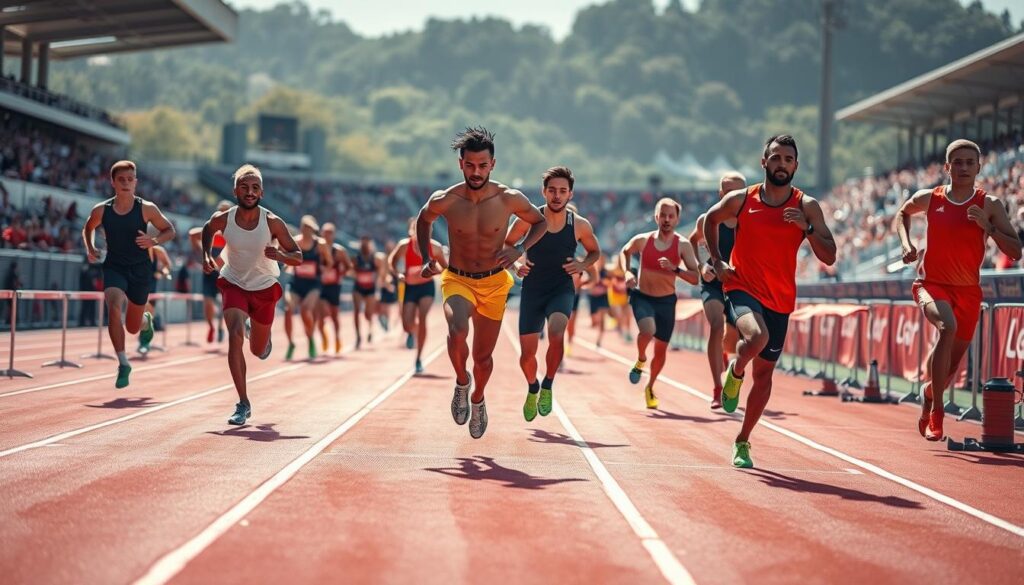As I laced up my running shoes and stepped onto the track, a surge of excitement flowed through my body. Track training has always been a voyage in the discovery and development of self for me. Here is a guide to help you unlock the secrets of track workouts and realize your full potential.
Track training is not just running laps; it is a holistic fitness approach including cardio, strength training, and special techniques. Those exercises will help you build muscles, increase your endurance level, and eventually boost your speed and agility. This is very instrumental in succeeding in different races.
Table of Contents

In this manual, you’ll learn the very basics of athletic performance. You will learn the most basic track workouts and strategies for endurance, strength, and speed. Get ready for a journey that will take you to realizing your fitness goals and more.
Understanding the Base of Athletic Performance
For the best results in sports, you have to condition your body and mind. Track training is really beneficial for athletes, as it prepares you to perform at your best.
Benefits of Track Training
Track training may have many advantages for your athletic performance. Here are some key benefits:
- Improved cardiovascular fitness and endurance
- Increased speed, power, and explosiveness
- Increased muscle strength and muscle endurance
- Better coordination, agility, and athleticism all around
Physical and Mental Preparation
For track events, physical preparation is paramount. That includes cardio such as running and interval training. Mental preparation is also important, whereby one does exercises that help in perfecting focus and resilience, such as meditation.
Setting Training Goals
Setting clear training goals keeps you focused and tracks your progress. Whether it’s faster sprints or better endurance, specific goals motivate you. They keep you focused and motivated to reach your goals.
Understand athletic performance and the benefits of track training, and you are aligned to success. You are well on your way to reaching your athletic goals.

| Metric | High School Athletes | College Athletes |
|---|---|---|
| Training Schedule | 6 days per week | 6-7 days per week |
| Training Components | Running drills, weightlifting, plyometrics, track workouts | Strength training, aerobic conditioning, flexibility exercises |
| Training Focus | Speed, agility, strength, endurance | Maximize capabilities, peak performance |
| Rest and Recovery | Sundays designated as rest days | Integral part of programming to prevent overtraining |
Must-Do Track Workouts for Speed and Power
Track workouts will help one improve on athletic skills. They increase speed and power. The exercises also strengthen your heart, making you agile, and are good for helping you jump higher.
Overhead squats, single-leg Romanian deadlifts, overhead lunges, and burpees really add a lot to that. These exercises work many muscles at once. It strengthens the body and makes it more flexible.

Sprinting is excellent in developing speed and strength. One study showed that runners who include speed workouts in their training sessions run better and longer; they could also go longer before getting tired.
Start with one track workout a week and then add on as you become fitter. Warm-up and cool down always—to get the best performance and stay safe.
Track Workout Essentials
- Add speed work once or twice a week for best results.
- Proper warm-up and cool-down are key for effective track sessions.
- Allow adequate recovery between track sessions to avoid overtraining.
- Adjust workout intensity, duration, and repetitions based on your fitness level.
- Incorporate some track-specific workouts, including sprints, hill repeats, and tempo runs.
Add these critical track workouts to your program, and you’ll hit peak athleticism. You’ll become faster and more explosive.
Building Endurance Through Cardio Training
When you’re a track athlete, you have to strengthen the endurance of your heart. You increase your stamina through cardio training, especially running long distances and doing intervals. It makes you better on the track.
Long-Distance Running Techniques
You should have long-distance running in your training. The American Heart Association advises getting at least 150 minutes of activity weekly. Workouts can go from 20 to 200 minutes, based on the objectives and your level of fitness.
When doing long-distance runs, keep a steady pace. This type of training makes your body better at using oxygen and fuel. It helps your muscles work more efficiently.
Interval Training Methods
Interval training is excellent for endurance as well. That includes short, intense sprints with rest in between. This improves your heart health and increases speed and power.
Try to stay at 60-70% of your max heart rate during intervals. Studies have shown that it will help improve sleep, immune systems, and brain function.
Recovery Strategies
Recovery is vital to avoid fatigue and injury. Cool down with stretching and foam rolling after workouts. Rest and sleep help your muscles heal and grow stronger.
Combined with long-distance running and interval training, recovery is going to develop the endurance needed for success in track.
Strength Training for Track Athletes
Strength training is critical for track athletes to help improve performance and reduce injury. Focus on big movements like squats, deadlifts, and bench presses. These exercises will help athletes develop the strength and power necessary for the track.
The Conjugate Method is a great program for track athletes. It combines exercises to work on strength, endurance, speed, and joint health. This method really allows you to tailor your training to your needs and the time of year.
Here are some important tips for strength training:
- Compound Exercises: Go for exercises that work many muscles at once. Examples of these would be squats, deadlifts, and pull-ups. It transfers strength to your athletic performance.
- Periodization: Change your training to fit your competition schedule and period of training. This might be off-season, pre-season, or in-season.
- Personalized Approach: Train with a coach or experienced trainer. They can design a strength training program that suits your needs and goals precisely.
Adding strength training to your routine can unlock your full potential as a track athlete. It will help you reach new heights of performance, speed, and muscle building. Remember, weightlifting for runners is an important part of your journey to success.
| Exercise | Sets/Reps | Effort |
|---|---|---|
| Compound Movements | 3-4 sets, 12+ reps | 50-60% |
| Strength-Focused Lifts | 3-4 sets, 6-10 reps | 70-80% |
| Power Exercises | 2-3 sets, 3-5 reps | 30-50% |
| Plyometrics | Low: 80-100 contacts Medium: 100-120 contacts Advanced: 120-140 contacts | – |
Sprint Training and Speed Development
To reach your athletic peak, focus on sprint training and speed development. These are key for track and field success. They can boost your performance to new levels.
Short Distance Sprinting Techniques
Short-distance sprinting should be learned for speed events. One must acquire the pickup of arm movement, high knee drive, and foot placement in order to blast off the line with power and speed.
Beginning Block Mastery
The starting blocks provide the key to a good, strong start in the sprints. Mastering them gives you that extra edge. Work on body position and a smooth transition into speed.
Acceleration Drills
Accelerating to your top speed is the most important thing. Doing certain drills will get you there fast. These exercises improve explosive power and speed build-up.
These additions to sprint training will make you fast and powerful. Just remember, that consistency and dedication are important for success in athletics.
Core and Stability Exercises
Being a track athlete, a strong core and stability are everything. It keeps your form right, makes running smoother, and keeps injuries away. These basics will increase your physical abilities and give you that mental edge to overcome any challenge in track.
Adding core strength and stability training to your routine can change the game. Exercises in planks, Russian twists, and on a stability ball target the key muscles, helping your spine, hips, and body alignment. A strong core means more power, better balance, and control in your track events.
Also, balance exercises are important. They keep you steady through the fast sprints, hurdles, and other track moves. Try single-leg stands, walking heel-to-toe, or using a BOSU ball. These exercises sharpen your body’s balance and quick response.
- Planks: Hold a tight plank position, and engage core muscles to maintain stability and control.
- Russian Twists: Sit on the floor, lean back a little, and twist your torso from side to side, engaging your obliques.
- Stability Ball Exercises: Use a stability ball to do all the exercises like crunches, leg raises, and many others that work for your core.
- Single-Leg Stands: Stand on one leg, working the core and leg muscles through balance and stability.
- Heel-to-Toe Walking: Give this simple exercise a try to challenge your balance and proprioception.
- BOSU Ball Exercises: Squat, lunge, and perform other exercises on a BOSU ball to increase your stability.
Core strength, stability training, and balance exercises should be part of your regular regimen, done 2-3 times a week. You’ll notice how they improve your athletic performance and reduce the risk of injury—a game-changer for your track career.
Periodization and Training Phases
Periodization is a smart way to organize your training for top athletic performance. It divides the year into phases to improve your progress and prepare your body to compete. Let’s look at the basic parts of periodization and how it helps in track and field.
Off-Season Training
The off-season is the key to your success. Use this period to build strength and endurance. This base is important for better sport-specific training later on. Mix weightlifting and cardio to improve your overall fitness.
Competition Phase Preparation
In the competition phase, your training gets more specific. You’ll work on speed, power, and technique to stand out on the track. This is when you refine your skills and keep your body in top shape with focused drills.
Peak Performance Timing
During the competitive phase, the training becomes very specific. You will work on speed, power, and technique for a great performance on the track. That’s when you fine-tune your skills and keep your body in great shape through particular drills.
| Training Phase | Duration | Focus | Intensity |
|---|---|---|---|
| Off-Season | 3-6 weeks | Strength and Endurance | Moderate to High |
| Competition Preparation | 4-8 weeks | Speed, Power, and Technique | High |
| Peak Performance | 1-2 weeks | Maintenance and Tapering | Moderate to Low |
Knowing periodization and having a structured plan will enhance your athletic performance. Just be patient and consistent. Your hard work will show on the track.
Recovery and Injury Prevention
Being a track athlete, recovery and injury prevention are the most important things. By using techniques such as stretching and foam rolling, you give your muscles time to recover; that way, you are ready for the next workout. If you do so, you will avoid injuries and be at the top of your game.
Recovery Techniques
- Begin with a good warm-up and cool-down to get the body ready and help it recover.
- Stretch often to boost flexibility and prevent injuries like strains and sprains.
- Use foam rolling to reduce muscle tension and aid in recovery.
Injury Prevention Strategies
- Don’t forget to take rest days for the body to recuperate and not overtrain, which may cause injuries.
- Eat right and hydrate to nourish your body, health, and healing.
- Strength training helps develop muscles and stability, which will help prevent track injuries.
| Injury Prevention Technique | Benefits |
|---|---|
| Hip and Core Strengthening | The hip-core strengthening group had a 39% lower rate of injuries compared to the control group (static stretching) and a 52% lower rate of ‘substantial overuse injuries’. |
| Foot and Ankle Strengthening | The foot-ankle strengthening group was found to be more injury-prone than the control group. |
| Proper Running Technique | Good posture, stride, and arm swing can lower injury risk and improve performance. |
Using these recovery techniques and injury prevention methods will keep you healthy and performing well. This will enable you to have a long and successful career in track.
Mental Conditioning for Track Excellence
With your mental game as important as the physical in a track athlete, the best way to unlock your full potential is to master the mental side of the sport. End.
Visualization Techniques
The most important tool for the best athletes is visualization. It helps them train their races mentally. They can improve their focus and relax their nerves by just imagining themselves racing well.
Regular visualization makes athletes feel more prepared and in control come race day.
Race Day Preparation
A set routine on race day sharpens your mental focus and performance. Try different pre-race activities like listening to music or doing breathing exercises until you find what works best for you.
This gets your mind and body ready to compete.
Performance Psychology
Mastering the mental side of your sport means having a winning mindset. The techniques for handling pressure and staying motivated include positive self-talk and goal setting. Embracing them will improve your mental game and help you achieve your track dreams.
FAQ
What is track training, and what are its benefits?
Track training refers to the type of training in which one gets fit by developing muscles, increasing strength, and burning fats. It increases your heart health, speed, and muscle endurance. The most effective way to get fit.
How do I prepare physically and mentally for track training?
Start with running and jump rope for cardio. Exercise that targets many muscles in your body at once. Meditation and set clear goals for your mind.
What are the essential track workouts for speed and power?
Exercises such as overhead squats and burpees are fundamental. They develop muscle and enhance your performance. Sprinting also helps improve your speed and heart health.
How do I build up endurance when doing cardio?
Practice running long distances at a constant speed. Incorporate interval training, where sprints alternate with rest. Stretch, cool down, and rest adequately to avoid fatigue or injury.
What are the fundamental sprint training methods?
Sprint training develops power and speed. Proper arm and leg movements should be used. Starting blocks and acceleration drills should be mastered.
Why are core and stability exercises important for track athletes?
They keep you stable and injury-free. You must perform exercises like planks and Russian twists. Building up your core helps running and also keeps you balanced better.
How does periodization work in track training?
It divides training into phases for better performance. Off-season builds strength, and the competition phase puts an emphasis on sport-specific training. Timing of your peak performance is important.
What are the best recovery and injury-prevention methods for track athletes?
Warm-up and cool down properly. Also, include stretching and foam rolling in your routine. Rest and eat right for recovery and injury prevention.
How can mental conditioning improve track performance?
Mental training is as important as physical. Visualization: Develop routines for race day. Positive thinking and goal setting elevate your mental game.
Looking for more fitness tips and workouts? Visit our Fitness category for a wealth of articles to support your fitness journey!

